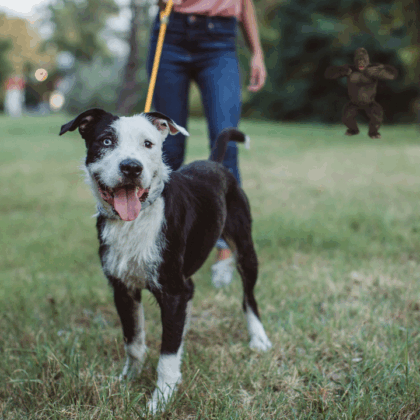Your brain is lying to you about what you see.
Right now, as you watch your dog, your mind is filtering, editing, and completely missing crucial information that could transform your relationship. This isn’t a character flaw or lack of intelligence. It’s how human brains are wired, and it’s sabotaging your dog training in ways you don’t even realize.
The famous “invisible gorilla” research by psychologists Daniel Simons and Christopher Chabris proves this dramatically. Participants watch a video of people passing basketballs and count the passes made by one team. Halfway through the video, someone in a gorilla suit walks directly through the scene, beats their chest, and walks off. Incredibly, about half the viewers completely miss the gorilla. They’re staring right at it, but their focused attention on counting passes creates what scientists call “inattentional blindness.”
This isn’t a laboratory curiosity. It’s happening every day in your interactions with your dog.
The High Cost of Missing the Obvious
Picture this scenario: You’re working on loose leash walking with your dog. You’re focused intently on whether the leash is tight or loose, applying your technique consistently, watching for improvement. Meanwhile, you completely miss the subtle stress signals your dog is showing – the brief lip lick, the slight weight shift away from a passing jogger, the momentary ear flick that signals uncertainty about something in the environment.
Three weeks later, your “friendly” dog lunges and snaps at another dog on your walk. “It came out of nowhere,” you tell people. But it didn’t. The signs were there all along. Your brain’s natural focusing ability, which seems like such an asset, blinded you to everything outside your narrow attention window.
Skilled observation isn’t about natural talent – it’s about systematic training to work with the brain’s limitations rather than against them.
The Science Behind What You Don’t See
Inattentional blindness is just one of several cognitive phenomena that affect how we perceive our dogs. Change blindness causes us to miss gradual shifts in behavior – the slow increase in arousal that builds toward reactivity, the subtle decrease in enthusiasm that signals developing pain or illness. Confirmation bias makes us see evidence that supports what we already believe while ignoring contradictory information.
When we expect a dog to be “naturally friendly” based on their appearance or breed reputation, we interpret every behavior through that lens, missing signs of stress or discomfort. When we’ve labeled a dog as “stubborn,” we stop looking for physical issues, fear, or confusion that might actually explain their behavior.
These aren’t personal failings. They’re predictable limitations of human perception that can be addressed through proper training.
Think Like a Field Scientist
Karl von Frisch spent decades watching honey bees before he decoded their famous “waggle dance” communication system. Not months or years – decades of patient, systematic observation until patterns emerged that revealed complex information sharing within the hive. His persistence earned him a Nobel Prize in 1973.
This is the mindset that transforms observation abilities: becoming a field scientist. Not the laboratory kind working under controlled conditions, but the ethologist studying behavior in the messy, complex real world where dogs actually live.
Every interaction with a dog becomes an experiment. You form hypotheses: “This dog is friendly.” “She’s ready to learn.” “He’s being stubborn.” Then you gather evidence. The problem is that most of us are terrible at evidence collection.
We see a wagging tail and conclude “friendly” – missing the stiff body language, the whale eye, the subtle weight shift backward that tells a different story. Our hypothesis was wrong because our evidence was incomplete. We fell victim to our brain’s tendency to see what we expect rather than what’s actually there.
Training Your Brain to See Differently
Systematic observation training addresses these cognitive limitations through specific types of practice. Rather than simply telling people what behaviors to look for, effective training develops the underlying perceptual abilities that make accurate observation possible.
This isn’t about learning more dog training techniques. It’s about developing the foundational skill that makes every technique more effective. Whether you’re a professional trainer working with reactive dogs or a devoted dog owner wanting to understand your companion better, accurate observation is where real relationships begin.
Because here’s the truth that transforms everything: seeing someone clearly for who they are, in that moment, is a sacred act of love. Every dog deserves to be seen as the individual they are, not filtered through our assumptions, expectations, or cognitive shortcuts.
When you truly see your dog, everything changes. Your timing improves because you’re responding to actual signals. Your training becomes more effective because you’re addressing real needs rather than perceived problems. Your relationship deepens because you’re finally having a genuine conversation instead of a one-sided monologue.
The patterns have always been there. Systematic observation training helps develop the skills to see them.
Learn more about systematic observation training: Observation Skills Part 1 – November 2025
GO BEYOND THE INVISIBLE GORILLA
Observation Skills Part One confronts the uncomfortable truth about human perception: we’re not nearly as good at seeing as we think we are. Through systematic practice with specific exercises, you’ll learn to:
Develop pattern recognition – like Karl von Frisch spending decades observing honey bees until he decoded their “waggle dance” communication system.
Create effective field notes – capturing complex, fast-moving behavior in ways that remain meaningful months later.
Practice scientific inquiry – approaching each interaction with curiosity, working hypotheses, and real-world research skills.
Enroll before October 12th and save $50 with Early Bird Dog Pricing!

